As a part of the deer family (Cervidae and Capreolinae), various species such as whitetail, mule deer, elk, moose, and caribou have a unique characteristic – antlers. Different from a regular horn, antlers are found on male deer or bucks and are an indicator of a buck’s health and genetic quality. So, how fast do deer antlers grow?
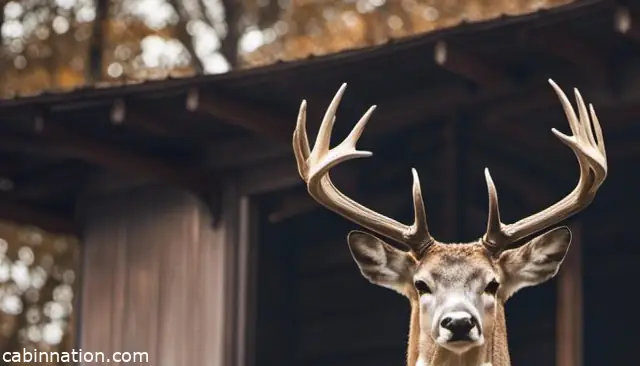
Contents
- How Long Does It Take For a Deer’s Antlers To Grow
- The Process of Deer Antler Growth
- Role of Seasons and Photoperiod
- Genetics and Age Factors Affect Antler Development
- Health Factors and Disease Influences
- The Impact of Habitat and Soil Quality
- Male Deer Antler Uses and Significance
- Unique and Abnormal Antler Characteristics
- FAQs: How Fast Do Deer Antlers Grow
- What factors affect the rate of antler growth?
- How do age and nutrition influence antler development?
- What is the timeline for a complete antler growth cycle?
- Are there differences in growth rates among deer species?
- Do environmental conditions impact antler growth rate?
- Can injury or stress alter the speed of antler growth?
- Related Articles:
How Long Does It Take For a Deer’s Antlers To Grow
A whitetail buck’s antlers can grow anywhere from 1/4 to 1/2 inch of length per day, slowing down towards the end of their growth cycle.
Antler growth is incredibly fast, making them one of the fastest-growing formations in nature. This rapid growth is triggered by increasing daylight and subsequent testosterone production.
During the growth process, the antlers are covered in a soft tissue called “velvet,” which supplies blood and nutrients necessary for healthy development. As the antlers mature, this velvet will naturally shed, revealing the hardened antlers bone structure underneath.
In terms of growth rate, the antlers’ beam (main stem of the antler) can grow 3 to 4 inches per week during particular stages. It reaches half of its growth in this stage, with all portions becoming visible.
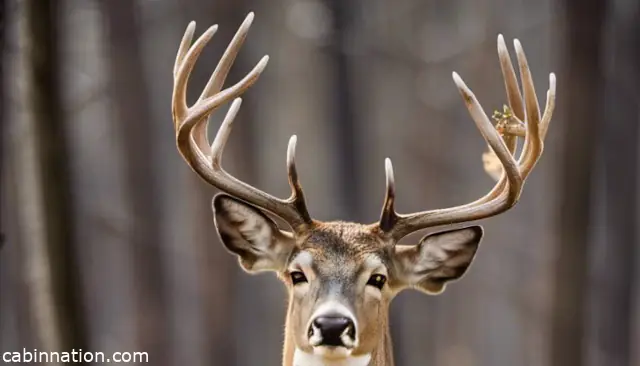
The Process of Deer Antler Growth
The antler regrowth cycle varies among species in the deer family. For example, the white-tailed deer and the mule deer go through an annual cycle of antler shedding and regrowth, while elk antlers and moose antlers have a multi-year shedding cycle.
Stages of Antler Growth
In the course of a deer’s life, its antlers undergo several stages of growth. The first stage begins with the development of pedicles – bony structures on a deer’s skull from which antlers emerge. These pedicles become more prominent as a deer matures which leads to the next stage of the antler growth cycle.
Antler growth is one of the fastest-growing formations in nature. This cycle typically spans 120 days, from late March through early August,
Role of Diet and Nutrition
One of the critical factors affecting maximum antler growth is the deer’s diet. Providing the right nutrients, such as calcium, phosphorus, protein, vitamins, and minerals, can significantly impact the development of a deer’s antlers.
The size and complexity of antlers can also differ depending on genetics, age, and diet of the buck. According to studies from the MSU Deer Lab and the Texas Parks and Wildlife Department, bucks that were on a 16 percent protein diet grew antlers twice as large compared to buck antlers on an 8 percent protein diet.
After four years, the bucks on the high-protein diet had antlers that scored about 20 inches higher on the Boone and Crockett scale.
Supplementing a deer’s natural diet with mineral supplements may also aid in antler growth by providing the essential nutrients needed for healthy bone development.
Hormonal Influence
Antler growth is highly influenced by hormones, specifically testosterone, and growth hormones. As the growth cycle progresses, hormonal changes in a deer’s body regulate the process.
In the early stages of antler development, growth hormones promote the growth of antler tissue like the velvet. As the cycle continues, testosterone levels increase, causing the velvet to shed and the antler’s growth to slow down.
Once the antlers have reached their full size, testosterone levels drop again, which leads to the shedding of the antlers and the beginning of a new growth cycle.
Role of Seasons and Photoperiod
During different seasons, deer antler growth rates vary significantly. In summer, antlers tend to grow at a faster pace, particularly between June and August.
This rapid growth is attributed to the longer daylight hours and warmer temperatures that support nutrient-rich forage availability. As summer progresses, the growth rate begins to decrease and eventually tapers off by late summer and early September.
In contrast, winter months exhibit a slower antler growth rate. With fewer daylight hours and colder temperatures, the availability of nutritious food sources is limited.
Consequently, deer allocate more of their energy toward basic survival, leaving fewer resources for antler development.
The photoperiod, or length of daylight hours in a 24 hour period, plays a crucial role in regulating deer antler growth. Deer are sensitive to seasonal changes in day length, and their physiological response is known as photoperiodism.
As daylight hours increase or decrease, it triggers an exogenous response in deer, causing them to adjust their physical and behavioral patterns accordingly.
Equinoxes mark the transition between seasons and can influence deer antler growth as well. Around the spring and fall equinoxes, the photoperiod changes more dramatically, causing a shift in deer behavior and antler development.
For instance, shortening summer days around the fall equinox can signal the approaching rut, during which bucks exhibit more aggressive behavior and are less focused on antler growth.
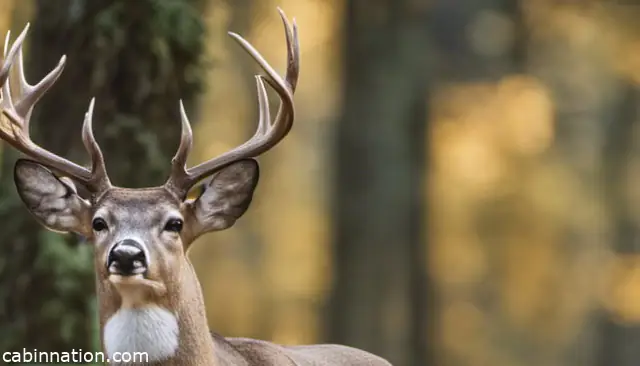
Genetics and Age Factors Affect Antler Development
As a deer’s antlers grow, genetics and age play crucial roles in shaping their development. Genetics provides the blueprint for antler shape and growth potential, while age determines the actual size and characteristics achieved over time.
Genetics has a significant impact on antler size and shape. Deer inherit genes from their parents, which determine the potential for large antlers or small antlers.
Some whitetail deer may have the genetic potential to grow “trophy-size” racks at a young age, while others may never develop impressive antlers, regardless of age or nutrition. It’s worth noting that exceptional antlers can be found on deer even in their middle-age (3.5 to 4.5 years).
On the other hand, age is an essential factor in antler growth as well. Deer antler growth cycle leads to larger and more complex antlers each year, generally reaching their peak size between the ages of 5 and 7.
Although genetics determine the potential for antler growth, age allows whitetail deer to reach their genetic potential over time. As deer age, they gain more mass and may develop additional points or tines on their antlers.
Environmental factors, such as nutrition and habitat, can also influence antler growth. However, these factors work in tandem with genetics and age to dictate the size and shape of a deer’s antlers.
A deer with good genetics but poor nutrition may never reach its full potential, while a deer with less desirable genetics but ample nutrition may outperform expectations.
Health Factors and Disease Influences
Deer antler growth is an impressive process, with antlers being able to grow up to 2 centimeters per day during the summertime when growth is at its peak. However, several health factors and diseases can influence this growth, both positively and negatively.
As I previously mentioned, adequate nutrition, such as protein concentration, plays a crucial role in antler development. This highlights the importance of a well-balanced diet rich in protein for healthy antler development in deer populations.
Injuries to deer can also have an impact on antler growth. For instance, a brain abscess or bacterial infection can lead to abnormal growths and deformation in the antlers.
The Impact of Habitat and Soil Quality
When it comes to the growth of deer antlers, one of the crucial factors that come into play is the habitat and soil quality. I found out that having a good quality habitat can contribute to significantly larger antlers in deer, as it provides them with the necessary nutrients needed for the growth process to take place efficiently and effectively.
Researchers at Mississippi State University, for example, found that good soil leads to larger antlers in deer populations. The reason behind this is that proper soil quality supports protein-rich forage, which feeds the deer and gives them the essential nutrients they need for optimal antler development.
Rainfall is another significant aspect that impacts soil quality and habitat as it directly influences the availability of forage. Adequate rainfall leads to better growth of protein-rich plants, which, in turn, results in faster and healthier deer antler growth.
Both soil and rainfall are vital, as they work together to offer the ideal conditions for deer to grow larger, more robust and bigger antlers.
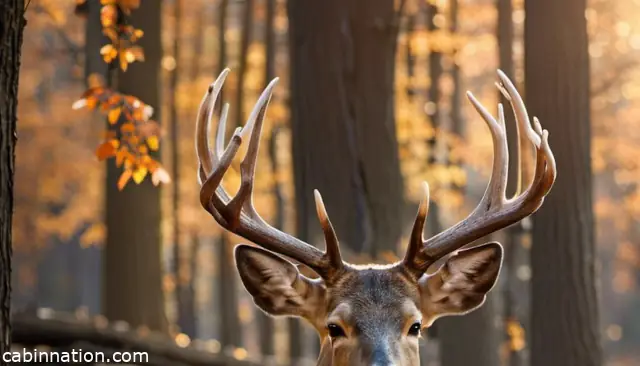
Male Deer Antler Uses and Significance
Deer antlers have various uses and significance, not only for the animals themselves but also for people.
Behavior and Dominance
During the mating season, bucks, or male deer, leverage their antlers for fighting and sparring with other bucks to establish dominance. This plays a crucial role in their ability to secure mates.
While having a larger set of antlers usually signals higher social status among the deer population, it’s important to note that the size of antlers isn’t the only factor determining a buck’s dominance: their strength and overall health play a significant role as well.
Shed Antlers
Antlers are not permanent structures, as deer shed antlers every year and buck grow new ones. The growth of antlers is an incredibly fast process, with blood vessels and essential nutrients being transported to the area by a specialized skin called velvet.
This annual growth and shedding cycle allows deer to display their strength and dominance each breeding season.
Deer Antler Uses and Discoveries
Deer antlers have long been admired and sought after by hunters for their unique beauty and as a symbol of the animal’s strength. Also deer antlers can be crafted into numerous crafts, tools, decorations, and furniture. Recently, there has been growing interest in the scientific community regarding deer antlers and their potential applications.
Additionally, deer antler has been used in Chinese traditional medicine for centuries as a powerful natural remedy for various ailments. This has sparked interest among scientists in further researching the potential medicinal benefits of antlers and their components.
Unique and Abnormal Antler Characteristics
Deer antlers grow at an incredible rate, and they demonstrate a complex structure throughout their development. Osteoblats are responsible for bone formation and growth of fresh antlers.
Antlers primarily form from spongy bone, which later turns into compact bone as mineralization occurs. This hardening process involves osteoclasts working to demineralize the bone..
Occasionally, abnormalities can occur in the growth and development of antlers. These abnormalities could include irregular tines, brow tines, or even entirely different horn structures.
In some cases, it may be a result of injury during antler growth or due to bacterial infections affecting the antler base. Other factors influencing abnormal growth can be nutritional deficiencies or genetic predispositions.
In addition to the unique bone structure, antlers display different characteristics for each deer. The number and shape of the tines can vary greatly, as well as the overall size and weight of the antlers.
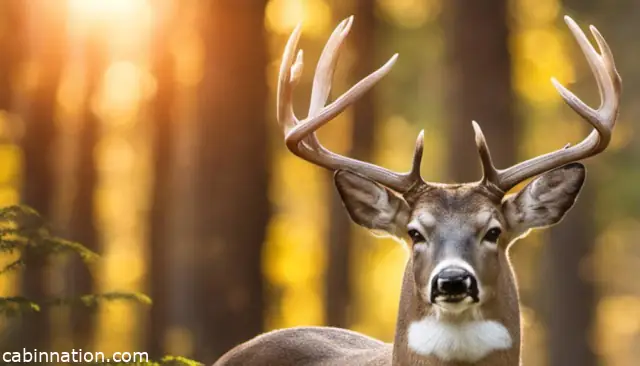
FAQs: How Fast Do Deer Antlers Grow
What factors affect the rate of antler growth?
Factors affecting antler growth rate include age, genetics, nutrition, and overall health of the deer. Environmental conditions also play a role in antler development. Any stress or injury affecting the deer can alter the growth rate too.
How do age and nutrition influence antler development?
As deer age, their antler growth rate generally increases until they reach their prime years, then decreases with further aging. Nutrition plays a critical role, with protein-rich forage significantly contributing to antler growth. Better habitat quality offers more nutrients, leading to larger antlers at any given age.
What is the timeline for a complete antler growth cycle?
The antler growth cycle takes around six months to complete. Beginning in late March or early April, antlers begin to grow over a period of 120 days until they reach their peak growth in late summer, followed by another month to harden and dry the velvet.
Are there differences in growth rates among deer species?
Yes, growth rates can differ among various deer species, depending on factors such as genetics and habitat.
Do environmental conditions impact antler growth rate?
Environmental conditions, including weather, food availability, and population density, affect antler growth rates. Harsh weather can limit deer movement and food access, resulting in slower growth, while higher population densities may lead to competition for resources, impacting antler development.
Can injury or stress alter the speed of antler growth?
Injuries or stress affecting a deer can indeed impact antler growth rates. Health issues caused by certain diseases, illnesses, or fungal infections may weaken or stunt antler growth. Physical trauma may also affect a deer’s antlers, causing deviations or reductions in growth.